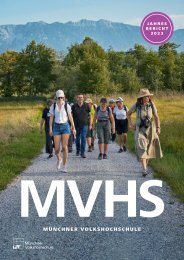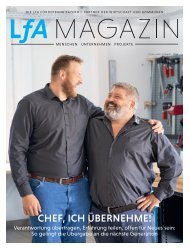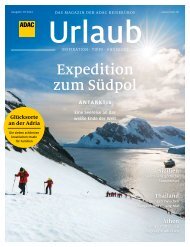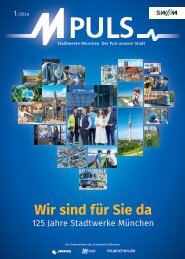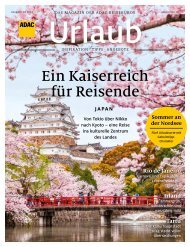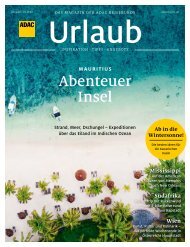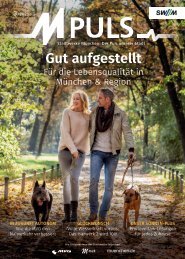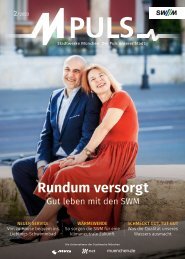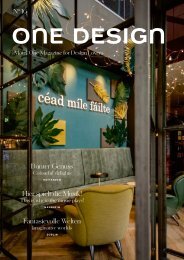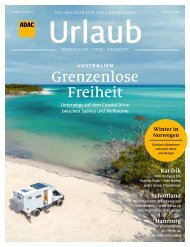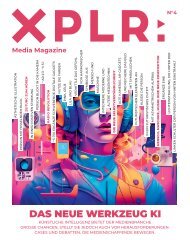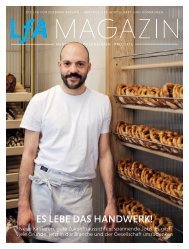ONELIFE #36 – English
Land Rover’s Onelife magazine showcases stories from around the world that celebrate inner strength and the drive to go Above and Beyond. This special issue of Onelife marks Land Rover’s 70th anniversary – a celebration of unparalleled achievement and pioneering innovation. We bring you the incredible story of how we reunited an original 1948 car with its former owners, as well as looking back at Land Rover vehicles’ most intrepid expeditions around the globe.
Land Rover’s Onelife magazine showcases stories from around the world that celebrate inner strength and the drive to go Above and Beyond.
This special issue of Onelife marks Land Rover’s 70th anniversary – a celebration of unparalleled achievement and pioneering innovation. We bring you the incredible story of how we reunited an original 1948 car with its former owners, as well as looking back at Land Rover vehicles’ most intrepid expeditions around the globe.
Create successful ePaper yourself
Turn your PDF publications into a flip-book with our unique Google optimized e-Paper software.
WORLD OF ADVENTURE<br />
“ADVENTURE IS STILL EXTRAORDINARY. TO FIND<br />
IT, TRAVEL, PREFERABLY OFF THE BEATEN TRACK,<br />
AND AWAY FROM THE PREDICTABLE”<br />
TIM SLESSOR, FIRST OVERLAND EXPEDITION MEMBER<br />
In September 1955, just over eight years after the<br />
launch of the first ever Land Rover, two Series I Station<br />
Wagons left Hyde Park Corner in London heading<br />
towards the Kent coast. It was the start of the now<br />
legendary 32,300-mile Oxford and Cambridge<br />
Far Eastern Expedition, a veritable first that would<br />
change vehicle-based expeditions forever.<br />
Their destination was the port of Singapore in<br />
Malaya, the trade hub of south-east Asia and the<br />
farthest point from London on the Eurasian land mass.<br />
Six undergraduates from the two renowned British<br />
universities, fired up by the fact that no land-based<br />
expedition had ever made it beyond Calcutta, had<br />
started making their plans twelve months previously<br />
over a cup of coffee in a student hall of residence.<br />
Former journalist and BBC documentary film maker<br />
86-year-old Tim Slessor, was one of them. An original<br />
member of the Oxford and Cambridge Far Eastern<br />
Expedition and author of the best-selling book First<br />
Overland, he is an intense but immediately likeable<br />
man. His bright eyes and sprightly gait tell the tale<br />
of an individual who has spent a lifetime pushing<br />
boundaries. He is perhaps too an original adventurer.<br />
The first of the 330,000 words he wrote in his<br />
expedition diary from the trip paraphrased legendary<br />
mountain climber and conqueror of Mount Everest<br />
Sir Edmund Hillary, “The main object of our Far<br />
Eastern Project is a jolly good adventure.” Intrigued,<br />
by how an 86-year-old journalist defines adventure<br />
today, there is also the more fundamental question<br />
of whether there are any real adventures left?<br />
Above: Series I Land<br />
Rovers SNX 891 ’Oxford‘<br />
and SNX 761 ‘Cambridge’<br />
during the Far Eastern<br />
Expedition in 1955<br />
Right: Tim Slessor back<br />
at the wheel of SNX 891<br />
at Eastnor Castle after its<br />
recovery from St Helena<br />
and recent sympathetic<br />
renovation by Land Rover<br />
enthusiast Adam Bennett<br />
“We had more opportunities than young people now,”<br />
Slessor says. “Today most of the possible first time<br />
adventures have been done.” Some things do not<br />
change however. “Adventure is still extraordinary, it is<br />
best done with friends and there has to be an element<br />
of risk. To find it, travel, preferably off the beaten track,<br />
and away from the predictable.”<br />
THE ULTIMATE TEST<br />
The vehicles were fundamental to the project, a fact<br />
the Rover Company immediately recognised along<br />
with the chance to generate some very useful public<br />
relations. As Tim recalls, “we thought the Rover people<br />
were joking when they said you have an opportunity to<br />
test the vehicles to destruction.” A year earlier in 1954,<br />
undergraduates had ‘overlanded’ to Cape Town and<br />
back in two Land Rovers. The lesson was obvious. “A<br />
tough four-wheel drive vehicle with low-ratio gears was<br />
essential. We concluded that the Land Rover was the<br />
only car suitable. We needed two and they cost 600<br />
pounds each, but we had 200 pounds between us.”<br />
The team needed financial support and an aim of<br />
conducting irrigation fieldwork provided justification<br />
that sponsors (of which there were 83 including the<br />
Rover Company and the BBC) required. Expedition<br />
cameraman Antony Barrington-Brown (known as BB)<br />
spoke to a young (now Sir) David Attenborough who<br />
had just joined the BBC but would later become the<br />
defining figure of the BBC’s world-renowned Natural<br />
History Unit. BB persuaded Attenborough to support<br />
the team with a camera and film, packing him on his<br />
PHOTOGRAPHY: ANTONY BARRINGTON-BROWN (4)<br />
30




